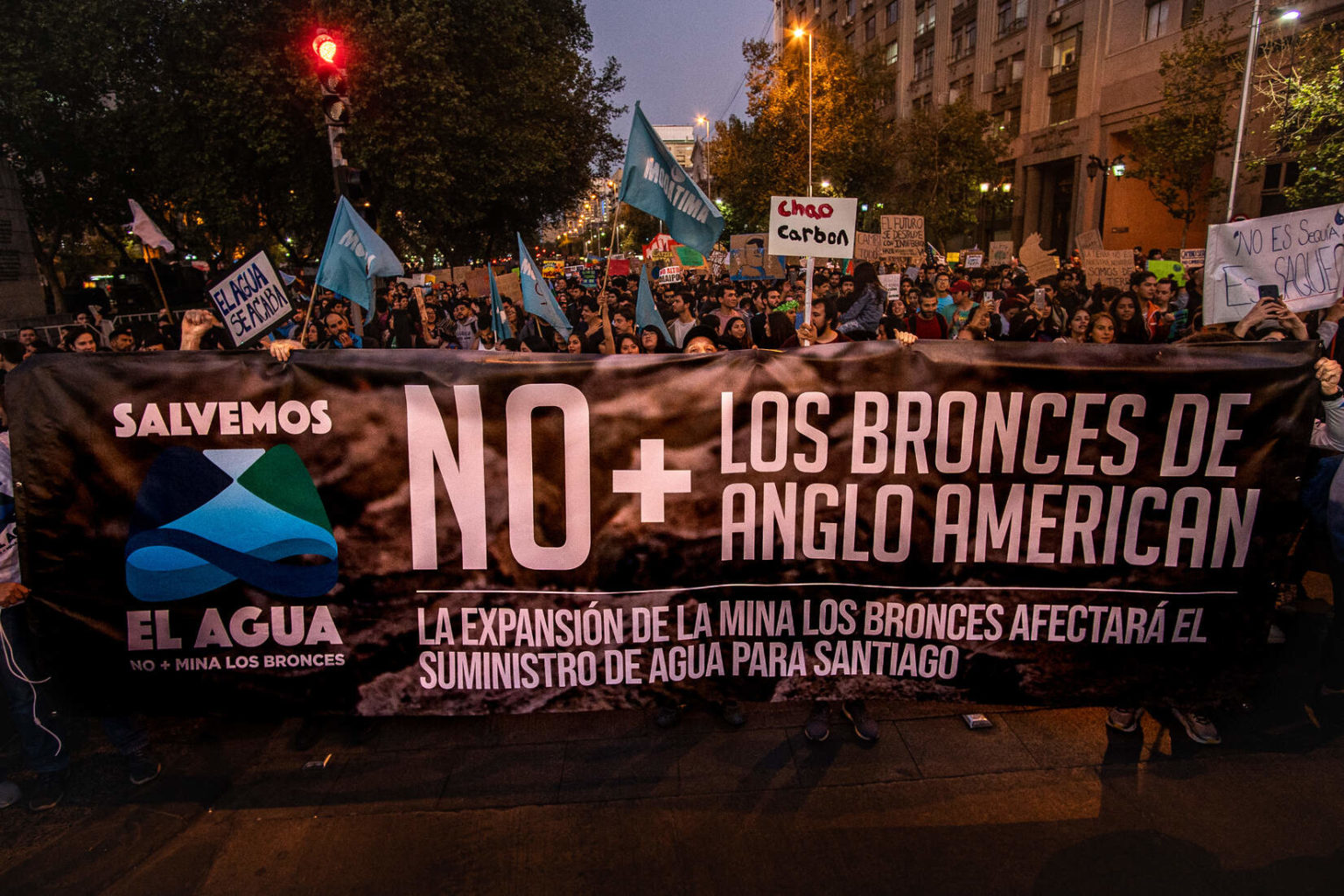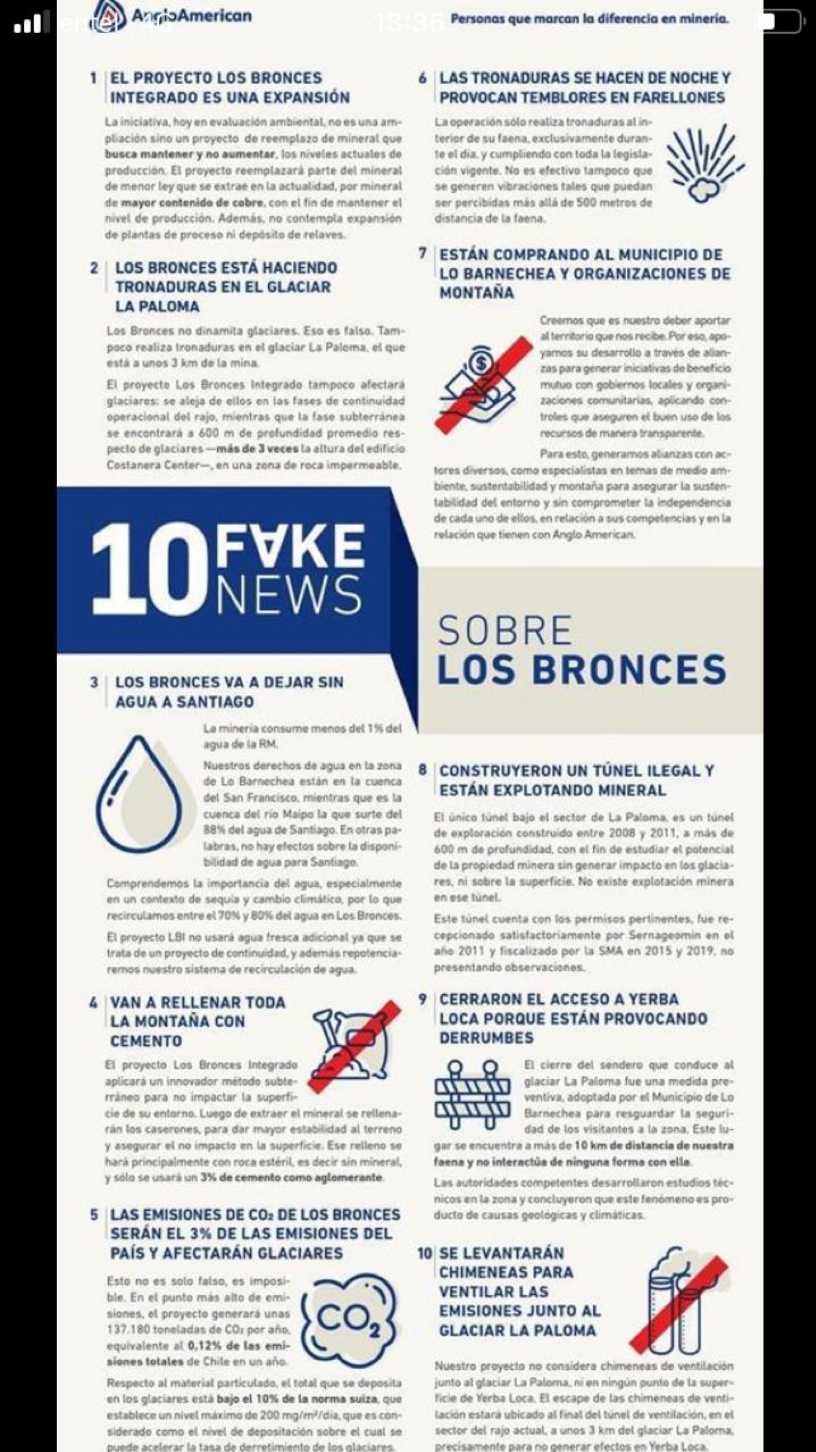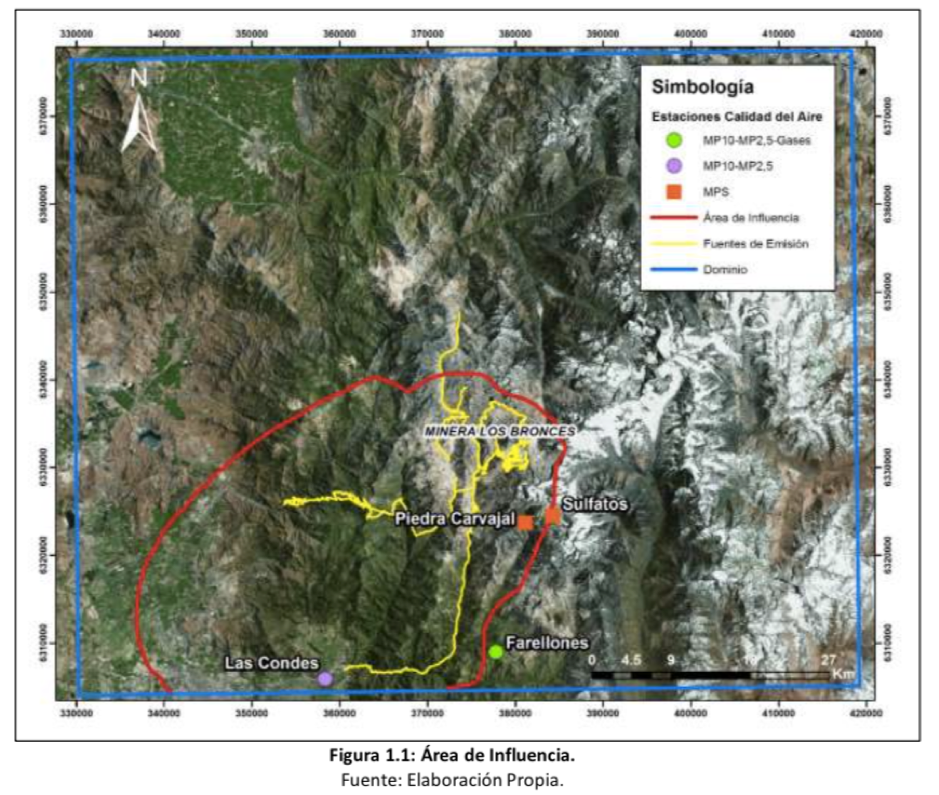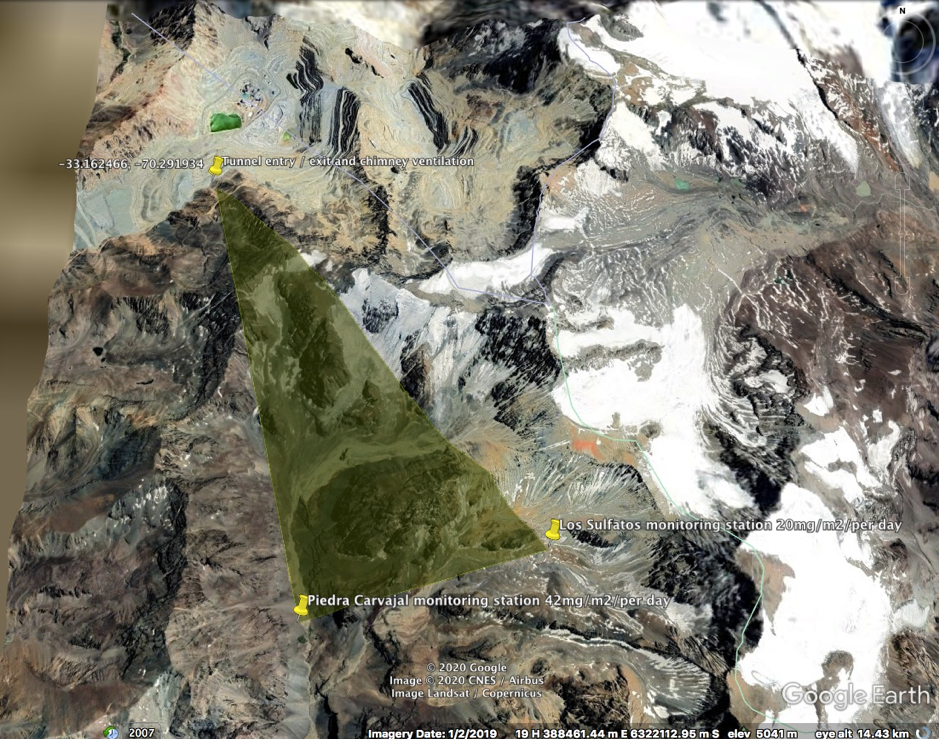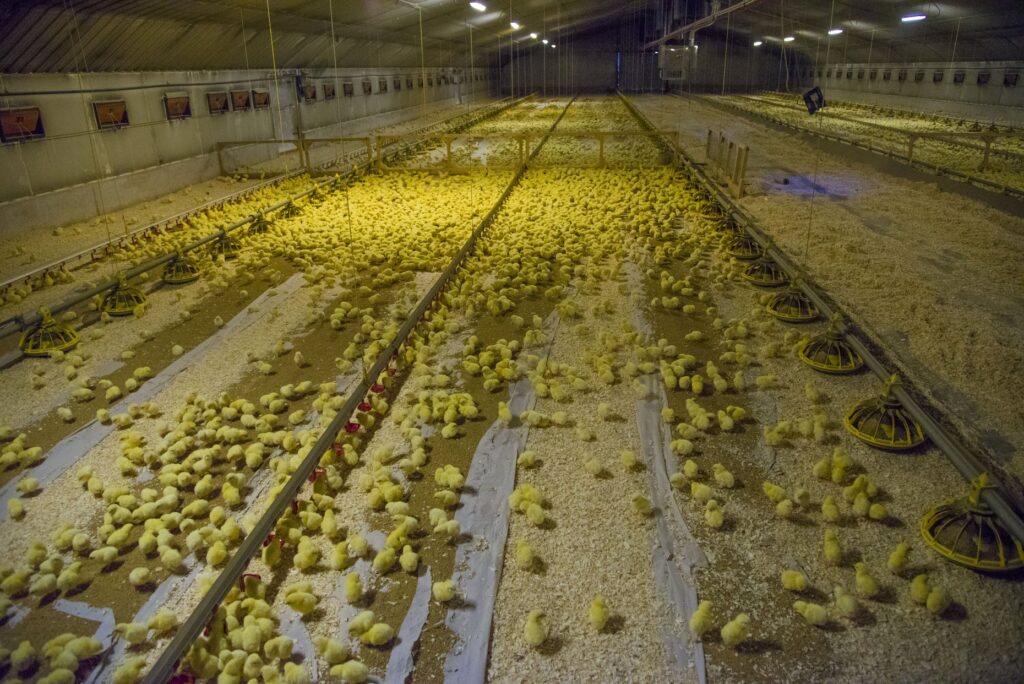Anglo American has undermined its plans for a controversial US$3 billion copper mine expansion beneath a Chilean nature sanctuary, 52 kilometres (32 miles) above Santiago in the Andean foothills. The multinational mining giant revealed an embarrassing technical blunder in its response to shareholders this May. According to Anglo American’s Environmental Impact Study (Spanish) released in July 2019, the first of six central design criteria for its Los Bronces underground mine expansion is avoiding impact to nearby glaciers, a critical freshwater supply already threatened by the climate crisis.
However, the mine’s design, DeSmog can now reveal, uses an entirely unrelated contamination measure for estimating impact to glaciers.
The expansion is already highly controversial. The Corporation for the Defense of the Mapocho Basin, a local grassroots organisation based close to the mine, claims the company is gambling with glacier damage and future freshwater supply for the London-sized city of Santiago with its 7 million inhabitants, home to almost half the nation’s population. The Chilean capital is currently in the tenth consecutive year of mega-drought, with 2019 rainfall in Santiago down 75 percent of 1981-2010 levels, the BBC reports. Anglo American’s current mining operations at Los Bronces have been a major consumer of scarce freshwater during this time. And a previous DeSmog investigation found that the cement production alone from the underground expansion would emit greenhouse gas pollution equivalent to as much as 9.7 percent of Chile’s national emissions.
DeSmog’s latest investigation has found:
- Anglo American has mistakenly applied Swiss contamination standards for dust deposits on soils to a glacier when attempting to prove its underground mine expansion will not damage glaciers.
- The company has published dust contamination levels from current operations at a monitoring site near glaciers that are considered already “highly polluted” for a glacier setting.
- This misapplied Swiss standard does not measure soot produced from mining operations, a pollutant that has a far greater negative impact on glacier melt-rate than dust. Current and future contamination of glaciers could therefore be far higher than Anglo American’s estimates.
- Dust and soot from the expanded copper mine would have to cross over or near a glacier system before reaching some of the company’s air quality monitoring stations.
The Shareholder Reveal
When the London Stock Exchange–listed company responded on May 7 to shareholder questions, Anglo American unintentionally revealed that its “internationally acclaimed and independent scientists and experts” have apparently mistakenly applied Swiss standards for soil contamination instead to a glacier setting in the expansion project’s environmental impact study.
The mining giant’s shareholder response states that “the effect on glaciers of mining activity is also low and represents less than 10 percent of the limit established by the Swiss regulation (200mg/m2/day).” Experts tell DeSmog there is no known standard for measuring such contamination impacts on glaciers.
When dark-coloured, heat-absorbing pollutants such as dust and soot land on white glacial surfaces, which typically reflect the sun’s rays, they help speed up glacier melt. That’s a major concern for Chile, which holds 82 percent of South America’s glaciers.
DeSmog contacted the Swiss Federal Office for the Environment (FOEN) about Anglo American’s use of this contamination standard. The FOEN replied: “The Swiss Ordinance on Air Pollution Control sets ambient limit values (ALV) for dust fallout of 200 mg/m2 per day as annual average. These ALV serve the purpose of soil protection and indirect health protection. They have no relation to glaciers.”
The Swiss Federal Institute for Forest, Snow, and Landscape Research also commented to DeSmog that “a definition of ‘safe’ would be difficult” for particulate matter deposits on glaciers and that “no such recommendation is known.”
Anglo American did not respond to requests for comment from DeSmog when presented with evidence from FOEN that the proposed Los Bronces expansion project is using values intended for soil rather than glacier settings.
Tracing the Swiss Norm
DeSmog first learned that Anglo American was potentially misapplying contamination measures to glaciers in November 2019. A Chilean community relations manager for Anglo American circulated a Spanish language document, obtained by DeSmog, titled “10 Fake News about Los Bronces” on Facebook and in the Farellones Road WhatsApp group of neighbours who live on the route leading up to the mine.
Figure 1: Point 5 in the Anglo American marketing document, “10 Fake News about Los Bronces,” addresses concerns about the project’s carbon dioxide emissions and glacier impact, which DeSmog previously uncovered.
The “fake news” document produced by Anglo American attempted to dispel negative publicity surrounding the project.
Yet it contained basic mathematical errors. Point 2 describes the 600 meter (1,968 feet) depth of the future mine’s underground infrastructure, including tunnels beneath glaciers, as being “over three times” the height of Santiago’s tallest building, which stands 300 meters (984 feet) tall.
In point 5, the 2019 “fake news” document mentioned the misapplied “Swiss norm” for glacier damage that reappeared months later in the company’s English language letter to shareholders.
The Swiss norm error was traced by DeSmog to Anglo American’s pending Environmental Impact Study (EIS) for the underground expansion. The project cannot go ahead without the Chilean government’s approval of the EIS. Both Chilean environmental consultants GeoAire and Jaime Llanes and Associates, which Anglo American contracted to produce the EIS, incorrectly applied this Swiss soil contamination standard to glaciers (02-Anexos Capítulo 3 – 1 de 6, Part II, p.10; and 01-Capítulo 4: Evaluación de Impactos, p.69, respectively.)
Glacier Damage
The question of whether Anglo American’s consultants are correctly calculating the impact of dust and soot on nearby glaciers could make a world of difference to these threatened sources of frozen freshwater. Glaciers are especially sensitive to a type of particulate matter, known as soot, that comes from combustion engines. Their melt rate can also be increased to a lesser extent by mineral dust in a mining context. The sensitivity of a glacial surface to these pollutants is different than that of soil where the Swiss norm is meant to be applied. Furthermore, Anglo American’s application of the Swiss norm, which measures only less harmful dust, implies soot particles are not being measured. Anglo American did not reply when DeSmog asked if the company is measuring only the mineral dust particles.
Anglo American will ventilate mineral dust and diesel emissions, including soot, from the future underground operation through chimneys (Executive Summary p.4) up into high elevation Andean winds, just 2.1 kilometres (1.3 miles) away from the nearest glacier.
Despite the proximity of these emissions sources to the glaciers, Anglo American has largely excluded nearby glaciers from the project design. The mining company considers these ice masses, located south of the mine’s ventilation chimneys, outside of the future project’s area of influence.
Figure 2: Environmental Impact Study, 02-Anexos Capítulo 3 – 1 de 6, Part II, p.6. Document prepared for Anglo American by GeoAire. The mine location is indicated by the consultant Geo Aire with the words “Mineria Los Bronces.” The red line shows the area that GeoAire estimates will be adversely affected by the mine’s air pollution.
“They seem to take no regard of the local geography or topography to delimit their area of influence,” Chilean-based geographer Dr. Alessa Geiger told DeSmog about the way Anglo American’s consultants decided the bounds of future air pollution from the project.
Anglo American repeatedly mentions the Swiss norm while referring to particulate matter data measured from its Los Sulfatos air monitoring to the south of the existing Los Bronces mine (see map below). The environmental impact study provides an average dust measurement of 19.9 mg/m2 per day (rounded to 20 mg/m2 per day by Anglo American) at this site between February 3, 2016 and March 7, 2018, 02-Anexos Capítulo 3 – 1 de 6, Part II, p.36. That value does come out to 10 percent of the daily standard which the Swiss apply to soil but as FOEN indicated, that standard does not extend to glaciers.
In addition, for particulate matter to reach the Sulfatos measuring site, it would need to pass directly over or near the glacier system to the south of the mine.
Figure 3: Google Earth map created by DeSmog showing the glacier-crossing flight path of particulate matter from mine sources before it reaches the Los Sulfatos and Piedra Carvajal measuring stations. The position of the respective measuring stations is taken from Anglo American’s Environmental Impact Study, 01-Capítulo 4: Evaluación de Impactos p.56. The coverage area is only a rough estimate and does not imply equal or exact distribution of particulate matter.
Furthermore, Anglo American provides this pollution data of 20 mg/m2 per day as justification, albeit erroneously using the Swiss norm, for the future mine. Yet this is historical data. The future mine expansion will include brand-new ventilation chimneys at the tunnel exit on the north face of the Paloma mountain. The tunnel exit sits at the periphery of the current open pit mine, just 2.1 kilometres from the southern glacier system. Should the mine be expanded underground, emissions will be ventilated from 20 tonne diesel lorries as they work underground, day and night, for at least 14 years, to remove 166 million tonnes of raw material from beneath the Yerba Loca Nature Sanctuary. Contamination of the glacier could therefore be far higher with this new emission source just a couple of kilometres from the glacier mass.
What’s Missing
The Sulfatos air monitoring site is on the eastern periphery of the area that Anglo American identifies as being influenced by the underground mine expansion, with the company drawing a boundary line for air quality impacts around far more territory to the west (see Figure 2). However, the predominant wind direction at the mine site is from west to east, Geiger explains, which would carry pollutants in the direction of the glaciers to the east of the mine.
Geiger, who investigates glacier changes at the Pontifical Catholic University of Chile, added, “It looks like they [Anglo American] just drew lines to have them on a map without really considering the implications in terms of micro and macro climate.”
Another air quality monitoring site, Piedra Carvajal, recorded a particulate matter reading more than double the average at Los Sulfatos — 41.7 mg/m2 per day — between January 27, 2016 and April 9, 2020. This data was not relayed to Anglo American shareholders in the May 7 letter. Piedra Carvajal, like Sulfatos, is south of the Anglo American mine and farther from the emission site than the glacier system, meaning that particulate matter recorded at this measuring station would also pass over or near the glacier before being recorded.
Read more: Revealed: Anglo American Mine Expansion Could Put Chile’s Glaciers and Emissions Goals At Risk
“41.7 mg/m2 per day can be viewed as highly polluted for a glacier,” Swiss glaciologist Dr. Fabrice Lambert told DeSmog. Like Geiger, Lambert works at the Pontifical Catholic University of Chile and is also part of the Centre for Climate and Resilience Research.
A 2014 study in Nepal led by glaciologist Patrick Ginot found that the buildup of particulate matter, including dust and soot, at an estimated rate of 27 mg/m2 per day increased glacier melt by more than a quarter. Both Ginot’s team and Lambert warn against making direct comparisons of melt rate on other glaciers around the world due to a range of factors, including different climatic conditions and the properties of the pollutants falling on the glaciers.
Accountability
Accountability is difficult in Chile where Anglo American openly gives money to environmental organisations in exchange for knowledge of their operations and instances of favourable presentations being given at their mining conferences.
The nationally owned copper company Codelco also has control over a 49 percent share of the Anglo American Los Bronces operation, meaning the Chilean government has a financial stake in the project’s expansion. Anglo American, according to its publicly available data, will have contributed US$1 billion to the Chilean government in 2019 through tax and profits from copper sales. The Servicio de Evaluación Ambiental, or Environmental Evaluation Service, is the Chilean government body that has the power to approve or ultimately reject the multi-billion-dollar Los Bronces expansion.
Due to the coronavirus pandemic, the Chilean government currently has suspended until July 31 its analysis of the Environmental Impact Study for the Los Bronces expansion and has not revealed a date for concluding the analysis. DeSmog understands that under Chilean law, Anglo American is able to alter and resubmit its EIS if elements are rejected.
Anglo American’s public relations surrounding the project have been plagued by errors and inconsistencies, particularly when communicating project details that involve understanding of mountain environments. In an April 2019 Twitter post, for example, Anglo American Chile conflated seasonal snow changes and glacier loss. It used side-by-side, low-resolution satellite photos of glaciers to the south of the mine to suggest that a snowier January 2019 image, compared to a leaner March 2018 one, proved that the glaciers were unaffected by the existing mine’s longtime presence.
Minería y medio ambiente pueden coexistir de manera armónica. Estas son imágenes recientes del glaciar la Paloma y a 5 km. al noroeste se encuentra, hace más de 150 años, la mina Los Bronces, compartiendo un entorno y re-imaginando la forma de hacer minería en la zona central. pic.twitter.com/u8FEknhXic
— Anglo American-Chile (@AngloAmericanCL) April 3, 2019
Previously Anglo American has told DeSmog that the company will not mount new chimneys to ventilate dust and soot from the underground expansion project. Anglo American then retracted this statement once the chimneys explicitly mentioned on page four of its Environmental Impact Study Executive Summary were referenced.
Anglo American’s technical errors cast doubt on the integrity of its environmental impact study for the massive copper mine expansion at Los Bronces. This comes at a time of extreme stress for the region’s water supply — and the world’s glaciers.
However, the possibility of gathering independent air quality measurements to stand up to Anglo American’s bungled numbers is not out of the question. The University of Chile owns the abandoned Infiernillo atmospheric measuring station within the Los Bronces mine site. In order to access this site, the university has to ask permission from the mining giant. No data has been collected since the 1980s. A 2019 publication about the history of the station has reignited the university’s interest in reactivating the station for meteorological and air pollution measurements, with potential for independently verifying pollution values.
A translated version of this story also appeared on Chilean independent investigative journalism platform, Interferencia
Main image: On September 27, 2019, protesters at Santiago, Chile’s global climate strike hide behind a banner that calls for the rejection of Anglo American’s Los Bronces mine expansion. Credit: ©Matt Maynard
Subscribe to our newsletter
Stay up to date with DeSmog news and alerts


